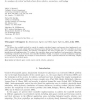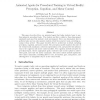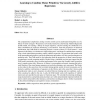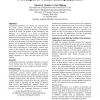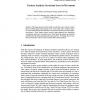SAB
2010
Springer
13 years 2 months ago
2010
Springer
The cerebellum plays a major role in motor control. It is thought to mediate the acquisition of forward and inverse internal models of the bodyenvironment interaction [1]. In this ...
ICRA
2010
IEEE
13 years 3 months ago
2010
IEEE
— We study target reaching tasks of redundant anthropomorphic manipulators under the premise of minimal energy consumption and compliance during motion. We formulate this motor c...
AAMAS
1999
Springer
13 years 4 months ago
1999
Springer
We discuss the tradeo s involved in control of complex articulated agents, and present three implemented controllers for a complex task: a physically-based humanoid torso dancing ...
AAI
1999
1999
Animated Agents for Procedural Training in Virtual Reality: Perception, Cognition, and Motor Control
13 years 4 months ago
This paper describes Steve, an animated agent that helps students learn to perform physical, procedural tasks. The student and Steve cohabit a three-dimensional, simulated mock-up...
ALIFE
2000
13 years 4 months ago
2000
The evolution of simulated robots with three different architectures is studied in this article. We compare a nonmodular feed-forward network, a hardwired modular, and a duplicatio...
JMLR
2008
13 years 4 months ago
2008
The computational complexities arising in motor control can be ameliorated through the use of a library of motor synergies. We present a new model, referred to as the Greedy Addit...
AI50
2006
13 years 8 months ago
2006
Abstract. This article discusses the issues of adaptive autonomous navigation as a challenge of artificial intelligence. We argue that, in order to enhance the dexterity and adapti...
CHI
2000
ACM
13 years 9 months ago
2000
ACM
Coordination definitions and metrics are reviewed from the motor control, biomedical, and human factors literature. This paper presents an alternative measurement called the M-met...
GW
2003
Springer
13 years 9 months ago
2003
Springer
This paper presents gesture analysis under the scope of motor control theory. Following the motor program view, some studies have revealed a number of invariant features that chara...
IROS
2007
IEEE
13 years 10 months ago
2007
IEEE
— While underactuated robotic systems are capable of energy efficient and rapid dynamic behavior, we still do not fully understand how body dynamics can be actively used for ada...

